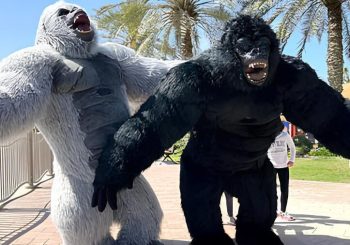In Arabic eco-literature, the sun, the skies, the sea, the mountains, and the trees are all silent storytellers. They are not just scenery, but silent companions, living each day, and each moment, alongside humans.
Within our own self-absorbed bubble, we may perceive life through a humanist lens, yet eco-literature shatters this illusion. It portrays the raw fabric of being, of existing, and of living the shared struggle for survival. It is easy to forget that the collapse of one species echoes through the ecosystem, yet in literature, one recognizes the reminder of the responsibility we hold for the symphony of life.
What will happen when nature no longer becomes predictable? When leaves fall and we can’t catch them, when seasons skip and the sea rises, and when nature, once a friend, becomes a stranger. Lost in a new world marked by storms and drought, one wonders: who are we when the ground beneath our feet shifts?
Eco-literature doesn’t always romanticize nature. It exposes the scars, the refugees, the colonialism, and the shattered lives left behind by environmental disasters. It’s a wake-up call to reflect the consequences of our actions on the environment surrounding us. As Libyan writer Ibrahim Al-Koni writes in The Bleeding Stone (2013), “man in the desert had to die by one of those two opposites: flood or thirst.”
Arabic eco-literature in particular delves into the complex relationship between environmental degradation and colonialism. The shared landscape becomes a battlefield, where the indigenous “self” and the foreign “other” clash over ownership and exploitation. These narratives offer a poignant perspective on the interconnectedness of nature, culture, and identity, exposing the lasting scars of colonialism on both the land and the people who call it home.
This article delves into the rich works of Arabic eco-literature, exploring three key themes highlighted by academic and researcher Allison McQuady: ecological nostalgia and yearning, the ecological native or indigenous person, and the wandering place.
Ecological nostalgia and yearning
Palestinian environmental writing grapples with a profound sense of ḥanin, also known as feelings of nostalgia and deep yearning for the land and longing for the homeland.
Colonialism, occupation, and displacement sever the umbilical cord to the past, leaving behind feelings of longing for a piece of land that is no longer inhabited by the indigenous people. Through the lens of “ecological ḥanīn,” Palestinian writers paint a poignant picture of environmental destruction.
It’s not just about damaged ecosystems, but about the sense of loss and displacement felt by people whose ancestral connection to the land is broken.
For example, in Standing before the Ruins of Al-Birweh (2011), Mahmoud Darwish writes about his memories of his former village of al-Birweh, which is a Palestinian village that was entirely removed and replaced by Israeli settlements.
In the poetry collection Journal of an Ordinary Grief (2010), memories of the lost village of al-Birweh represent not just human loss, but also environmental loss. Darwish references each familiar tree and flora, which is a testament to generations of cultivation.
As Darwish eloquently writes: “A place is not only a geographical area; it’s also a state of mind. And trees are not just trees; they are the ribs of childhood.
The ecological native or indigenous person
The character of the fellah, or the farmer, is an essential component of Arabic eco-literature. Care for the land by the fellah nourishes not just families but also the spirit of a community bound together by their collective stewardship.
For example, Abdel Rahman al-Sharqawi’s novel The Land (1954) transports us to an Egyptian village in the 1930s, exposing the devastating ecological consequences of political and social injustices, and how these injustices affect Egypt’s ecology and environment.
Through the villagers’ struggles, Sharqawi challenges the artificial separation of man and nature, highlighting the connection between human suffering and the ravaged land. An ecocritical lens reveals the novel’s profound environmental potential.
But the novel is not just a story of oppression, it also forces us to reflect and asks us to confront one’s identity in relation to the land. The novel breathes life back into peasant culture, reclaiming the fallaḥ (Egyptian farmer) as a central figure in the nation’s consciousness.
For centuries, colonization and foreign dominance had cast a long shadow on this vital strand of the Egyptian identity. The fellah became more than just a farmer; he was a symbol of resilience, self-reliance, and an unwavering connection to the soil.
The novel highlights the connection between social liberation and environmental liberation, highlighting the social, agricultural, and economic struggles that burdened the fallaḥ’s existence and how these struggles are heightened by oppressive systems of power.
The wandering place
In Arabic eco-literature, the desert or the environment is a character on its own, with its own storylines and plots that intertwine with those of the human characters.
In The Bleeding of the Stone (2013), Ibrahim al-Kuni doesn’t simply describe the desert; he invites us to experience it. Through detailed descriptions, he breathes life into the desert’s fauna and flora. As he potently writes: “It pleased him to stoop down and contemplate the small leaves that had cracked the layer of mud and raised their heads from the void…they’d ripped through the veil of darkness to find joy in open spaces.”
Beneath the desert’s scorching sun, a deep well of spirituality lies hidden. The desert encourages its characters to confront their inner world and to connect with their spiritual state of being. The characters learn that survival hinges not on fortune or favor, but on their own grit, courage, and unwavering ability to read the desert’s language.
Through their trials, the characters become acutely aware of their place within the desert’s larger ecosystem. They learn that nature’s gifts are not a divine blessing granted solely to them, but a shared resource, one that sustains a myriad of creatures. As al-Kuni writes: “Water grants life to the desert, just as it had granted death to his old mother.”
The characters learn to live in the desert not as conquerors, but as participants in an unpredictable flow of life






Comments (0)